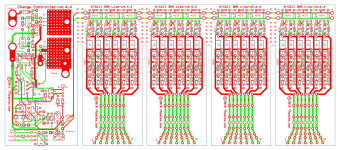I don't know all the costs just yet, so for those PM'ing me for that info, I'm sorry, but I hope to figure that out soon. I'll post the info here.
We've been doing two parallel efforts, this 12s2p "Lite" variant, and the version that is CellLog-based. The boards for the CellLog version were submitted Friday, and I will get them tomorrow. In the meantime, Richard and I have been working on the this "standalone" Lite variant. Mainly what we are changing, for both versions, is the charge controller section. Based on the issues we've seen with the full Zephyr BMS controller, we wanted to simplify things for both this version and for the CellLog variant. With the Zephyr charge controller, there was an auto-shutoff function that monitored the charge current, and shut off the charge current, and the main LED, when the current dropped below a preset level. For the Lite variants, what will happen is that the LED will stay on, and be solid green at the end of the charge process. If the individual red shunt LEDs are off, and the LED is green, the charge process is complete. Unplugging the charger/supply, at that point, resets the circuit and the LED stays off until the next time the charger supply is connected. During the CC charge phase, the main LED will be orange. If there is an imbalance, the shunts for the high cells will come on, along with their respective LEDs. Once the main LED is green and all the shunt LEDs are off, the pack is fully charged and balanced.
Anyway, today I'm hoping to finish the layout changes for the basic 12s2p version. Initially, at least, I'm probably just going to do this one, plus a slightly larger version that will work with the Zippy 6s-8000 packs. I like these a lot because one 12s2p setup of these has more capacity than a 12s3p configuration of 5Ah packs.

-- Gary


